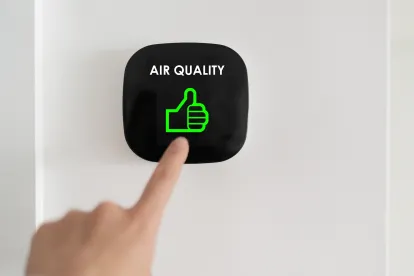On March 15, 2023, the Environmental Protection Agency (EPA) released a signed prepublication version of a final rule, “Federal ‘Good Neighbor Plan’ for the 2015 Ozone National Ambient Air Quality Standards” (Final Rule or Rule). The Rule would establish a federal implementation plan (FIP) for further reducing oxides of nitrogen (NOx) emissions from fossil fuel electric generating units (EGUs) and from certain manufacturing and industrial sectors to help downwind states meet the 2015 National Ambient Air Quality Standard (NAAQS) for Ozone.
The Rule covers twenty-three states in total (Alabama, Arkansas, California, Illinois, Indiana, Kentucky, Louisiana, Maryland, Michigan, Minnesota, Mississippi, Missouri, Nevada, New Jersey, New York, Ohio, Oklahoma, Pennsylvania, Texas, Utah, Virginia, West Virginia, and Wisconsin) with six additional states that will likely be included in the near future (Arizona, Iowa, Kansas, New Mexico, Tennessee, and Wyoming). Only non-EGU sources are covered in California. EGUs in the other twenty-two states will be required to comply with the Cross-State Air Pollution Rule (CSAPR) NOx trading program by the 2023 ozone season starting this May. Covered industrial sources in twenty states will have to comply with requirements starting in 2026.[1]
Background
The last update to the Ozone NAAQS was in 2015, with EPA currently reviewing whether to revise that level. When EPA sets a NAAQS, states must develop within three years State Implementation Plans (SIPs) detailing the implementation, maintenance, and enforcement of each NAAQS. Importantly, states are required to include in their SIPs adequate provisions to show that sources of emissions from within the state do not “contribute significantly” to nonattainment or interfere with maintenance by any state with respect to NAAQS. This provision is called the “good neighbor” or “interstate transport” provision of the Clean Air Act (CAA).[2] If EPA finds that a state has not submitted a good neighbor SIP or if EPA disapproves a state’s SIP, the statute requires EPA to issue a FIP within two years.[3]
In 2016, EPA promulgated the Cross-State Air Pollution Rule (CSAPR) Update to address interstate transport of ozone pollution regarding the 2008 Ozone NAAQS.[4] The final rule updated the CSAPR ozone season NOx emissions budgets for twenty-two states and aligned implementation of the rule with the 2017 ozone season. In December 2018, EPA promulgated the CSAPR “Close-Out” which determined that no further reductions in emissions of NOx were required regarding the 2008 Ozone NAAQS for twenty of the twenty-two eastern states covered by the CSAPR Update.
The good neighbor requirements have sparked litigation over the years, including over both the CSAPR Update and the CSAPR Close-Out, leading to additional rulemakings by EPA. The D.C. Circuit remanded both the CSAPR Update and the CSAPR Close-Out because they did not fully account for upwind states’ significant contribution to nonattainment or interference for maintenance of the 2008 Ozone NAAQS by the downwind states’ deadlines as required by the CAA.[5] In response, EPA promulgated the Revised CSAPR Update in on April 30, 2021.[6] In the Revised CSAPR Update, EPA determined that the rule was a complete remedy for certain states, while other states significantly contributed to downwind states’ ability to meet nonattainment or maintenance requirements. For the states still contributing to nonattainment or maintenance issues, EPA issued new or amended FIPs and required compliance with revised emissions budgets beginning with the 2021 ozone season. EPA found that implementation of the Revised CSAPR Update fully eliminated these states’ significant contributions to problems with downstream states meeting their requirements under the CAA. Recently, on March 3, 2023, the D.C. Circuit denied a challenge to the Revised CSAPR Update by an association of power companies and utilities in Midwest Ozone Group v. EPA.[7] The court upheld EPA’s air quality analysis as an appropriate exercise of EPA’s statutory authority under the good neighbor provision of the CAA.
EPA proposed the Good Neighbor Plan for the 2015 Ozone NAAQS on April 6, 2022.[8]
Requirements for EGUs
Fossil fuel-fired EGUs in twenty-two states will be required to comply with the revised and strengthened CSAPR program starting in the ozone season for this year so that downwind states can attain the 2015 Ozone NAAQS by the prescribed statutory deadlines. The CSAPR program accomplishes NOx reductions through a trading program where each state receives a limited number of allowances (referred to as a NOx budget) that will be allocated to covered EGUs in that state. Affected EGUs then use those allowances to cover emissions of NOx during the ozone season.
The Rule finalizes several features to make the trading program more stringent. Of note is that EPA is determining preset state emissions budgets for control periods 2025 through 2029, in addition to the 2023 and 2024 periods as proposed. However, once past control year 2026, EPA will compare the preset value with a new analysis of recent data for unit heat input values and emission rates, and if the new analysis yields a higher level of allowable emissions than the preset budget it becomes the new standard. This establishes a “dynamic budget” with the preset values as a floor.
Another important new feature is that the Rule finalizes the proposed “backstop” daily NOx emission rate of 0.14 lb./MMBtu on each covered large coal-fired EGU during the ozone season. The backstop daily rate corresponds to the NOx emission level achieved through the application of selective catalytic reduction (SCR). The backstop limit first applies in 2024 to covered EGUs with SCR installed and then is extended to one year after SCR installation (but no later than 2030), to apply to all existing covered EGUs including those that may not have SCR. For an EGU that exceeds the daily backstop limit beyond 50 tons, a 3-for-1 allowance surrender ratio will be imposed on a daily basis instead of the normal 1-for-1 allowance surrender ratio for the control period.
Requirements for New Industrial Sectors
The Rule will impose emissions rate limits starting in 2026 on nine industry sectors in twenty states.[9] Covered industry sources include, among others: reciprocating internal combustion engines in pipeline transportation of natural gas; kilns in cement and cement product manufacturing; reheat furnaces in iron and steel mills and ferroalloy manufacturing. [10] EPA eliminated emissions limits for certain categories originally contained in the proposal, including steel furnaces and concrete plants. The Rule exempts certain categories, including “low-use” boilers across multiple industries. EPA also may examine and issue on a case-by-case basis exemptions from standards where owners can demonstrate limits are either technically impossible to meet or that the limits would cause extreme economic hardship. With EPA’s approval, individual affected non-EGU facilities may be eligible for a one-year compliance extension until 2027 and if additional criteria are met, EPA has the authority to grant additional compliance extensions of up to two or more years until as late as 2029. Covered industries will not be part of the CSAPR emissions trading program already established for EGUs.
Costs and Benefits
EPA estimates the cost of meeting the new standards to be approximately $910 million annually over the period 2023 to 2042. EPA estimates the benefits in 2026 will be $4.3 billion. Taking into account costs of compliance, the benefits are estimated to be $3.7 billion. EPA also estimates that the net present value of the rule over the period 2023 to 2042, after taking into account compliance costs, is $200 billion.
Next Steps
The various iterations of rules addressing interstate transport have been very contentious and this final rule is no exception. Already several states are challenging EPA’s issuance of disapprovals of good neighbor SIPs, which serve as the predicate for imposing the new FIP. In addition, newly covered industrial sources may seek to overturn the Rule given that these industries are already complying with federal and state standards. The Final Rule will take legal effect 60 days after publication in the Federal Register.
FOOTNOTES
[1] EPA is requiring the increased standard for EGUs for the 2023 ozone season because the primary standard attainment deadline in moderate nonattainment areas is August 2024. EPA is requiring the standard for non-EGU new industrial sources because the primary standard attainment deadline in serious nonattainment areas is August 2027.
[2] 42 U.S.C. § 7410(a)(2)(D)(i)(I).
[3] 42 U.S.C. § 7410(c)(1).
[4] 81 Fed. Reg. 74,504, 74,511.
[5] Wisconsin v. EPA, 938 F.3d 303, 313-15 (D.C. Cir. 2019); New York v. EPA, 781 Fed. App’x 4, 7 (D.C. Cir. 2019).
[6] 86 Fed. Reg. 23,054 (Apr. 30, 2021).
[7] No. 21-1146 (D.C. Cir. Mar. 3, 2023).
[8] 87 Fed. Reg. 20,036 (Apr. 6, 2022).
[9] The new emissions limits for manufacturing industries will apply in Arkansas, California, Illinois, Indiana, Kentucky, Louisiana, Maryland, Michigan, Mississippi, Missouri, Nevada, New Jersey, New York, Ohio, Oklahoma, Pennsylvania, Texas, Utah, Virginia, and West Virginia.
[10] The regulated industrial sources also include furnaces in glass and glass product manufacturing; boilers in iron and steel mills and ferroalloy manufacturing, metal ore mining, basic chemical manufacturing, petroleum and coal products manufacturing, and pulp, paper, and paperboard mills; and combustors and incinerators in solid waste combustors and incinerators.







 />i
/>i
